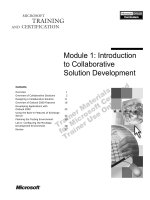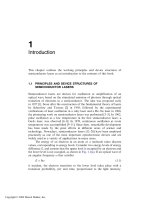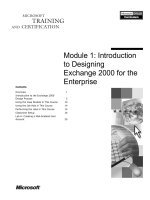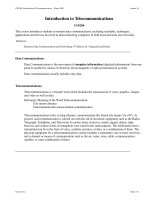1 introduction basic tools market structure
Bạn đang xem bản rút gọn của tài liệu. Xem và tải ngay bản đầy đủ của tài liệu tại đây (430.93 KB, 50 trang )
Industrial Organization: contemporary theory
and practice (3rd edition)
Lecture notes
Industrial Organization: Chapter 1
1
Introduction
• How firms behave in markets
• Whole range of business issues
– price of flowers; payment to be official sponsor of
major events
– which new products to introduce
– merger decisions
– methods for attacking or defending markets
• Strategic view of how firms interact
Industrial Organization: Chapter 1
2
• How should a firm price its product given the
existence of rivals?
• How does a firm decide which markets to
enter?
• Incredible richness of examples:
–
–
–
–
–
Microsoft/Netscape/Sun
ADM (collusion)
Toys R Us (exclusive dealing)
American Airlines (predatory pricing)
Merger wave
• At the heart of all of this is strategic interaction
Industrial Organization: Chapter 1
3
• Rely on the tools of game theory
– focuses on strategy and interaction
• Construct models: abstractions
– well established tradition in all science
• physics
• engineering
– are SUVs safe?
– Do seat-belts/Volvos save lives?
Industrial Organization: Chapter 1
4
The New Industrial Organization
• The “New Industrial Organization” is something
of a departure
– theory in advance of policy
– recognition of connection between market
structure and firms’ behavior
• Contrast pricing behavior of:
–
–
–
–
grain farmers at first point of sale
gas stations: Texaco, Mobil, Exxon
computer manufacturers
pharmaceuticals (proprietary vs. generics)
Industrial Organization: Chapter 1
5
• Do not say much about the internal
organization of firms
– vertical organization is discussed
– internal contracts are not
Industrial Organization: Chapter 1
6
Anti-trust Policy: an overview
• Developments in modern IO are sensitive to
the policy context
– Microsoft and ADM
• highlight aspects of developments in policy/law and
economic theory
• Need for anti-trust policy recognized by
Adam Smith (1776)
– “The monopolists, by keeping the market
constantly understocked, by never fully
supplying the effectual demand, sell their
commodities much above the natural price.”
Industrial Organization: Chapter 1
7
– “People of the same trade seldom meet together,
even for merriment or diversion, but the
conversation ends in a conspiracy against the
public, or in some contrivance to raise prices.”
• Sherman Act 1890
– Section 1: prohibits contracts, combinations and
conspiracies “in restraint of trade”
– Section 2: makes illegal any attempt to monopolize
a market
– contrast per se rule
• collusive agreements/price fixing
– rule of reason
• “unreasonable” conduct
Industrial Organization: Chapter 1
8
• Clayton Act (1914)
– intended to prevent monopoly “in its incipiency”
– makes illegal practices that “may substantially
lessen competition or tend to create a monopoly”
• Federal Trade Commission established in the
same year
• However, application affected by rule of
reason
– proof of intent
– “the law does not make mere size an offence or
the existence of unexerted power an offence - it
does not compel competition nor require all that is
possible.”
Industrial Organization: Chapter 1
9
• Robinson-Patman (1936)
– prohibits price discrimination that is intended to
lessen competition
– intended to prevent aggressive price discounting
• The Alcoa case (1945) was also important
– 90% market share
– expanded capacity in advance of market expansion
– inferred anti-trust violation from structure and
conduct without overt evidence
• More relaxed attitude in last two decades
– emergence of large firms: merger waves
– importance of global competition
Industrial Organization: Chapter 1
10
The New Industrial Organization
• Dissatisfaction with the structure-conductperformance approach
– collect profit data on firms in an industry
– explain differences using information on size,
organization, R&D, financial leverage etc.
– but what is the direction of causation?
• The “old” IO has limited treatment of product
differentiation
– representative firm, little strategic interaction
• New IO: strategic decision-making (Hotelling)
– scheduling of “blockbuster” and Disney movies
Industrial Organization: Chapter 1
11
Basic Microeconomic Tools
Chapter 2: Basic Microeconomic Tools
12
Efficiency and Market Performance
• Contrast two polar cases
– perfect competition
– monopoly
• What is efficiency?
– no reallocation of the available resources makes one
economic agent better off without making some other
economic agent worse off
– example: given an initial distribution of food aid will
trade between recipients improve efficiency?
Chapter 2: Basic Microeconomic Tools
13
• Focus on profit maximizing behavior of firms
• Take as given the market demand curve
$/unit
A
Equation:
Equation:
PP==AA--B.Q
B.Q
linear
linear
demand
demand
P1
Maximum
Maximumwillingness
willingness
totopay
pay
Constant
Constant
slope
slope
Demand
• Importance of:
– time
– short-run vs. long-run
– willingness to pay
Q1
A/B Quantity
At
Atprice
pricePP11aaconsumer
consumer
will
willbuy
buyquantity
quantityQQ1
1
Chapter 2: Basic Microeconomic Tools
14
Perfect Competition
• Firms and consumers are price-takers
• Firm can sell as much as it likes at the ruling market price
– do not need many firms
– do need the idea that firms believe that their actions will not affect
the market price
• Therefore, marginal revenue equals price
• To maximize profit a firm of any type must equate marginal
revenue with marginal cost
• So in perfect competition price equals marginal cost
Chapter 2: Basic Microeconomic Tools
15
MR = MC
•
•
•
•
•
•
Profit is (q) = R(q) - C(q)
Profit maximization: d/dq = 0
This implies dR(q)/dq - dC(q)/dq = 0
But dR(q)/dq = marginal revenue
dC(q)/dq = marginal cost
So profit maximization implies MR = MC
Chapter 2: Basic Microeconomic Tools
16
Perfect competition: an illustration
With
market
demand
DD2
With
market
demand
2
• The supply curve moves to the right
With
market
demand
D
1
With
market
demand
D
and
market
and
marketsupply
supplySS111
(a) The Firm
(b) The
Industry
and
market
SS1P
• Price falls
and
marketsupply
supply
equilibrium
price
With
1P
1
equilibrium
priceisis
Withmarket
marketprice
pricePPCC
1
equilibrium
price
is
P
$/unit
$/unit
C
• Entry continues while profits exist
equilibrium
priceisisisQQP1 C
and
the
andquantity
quantity
thefirm
firmmaximizes
maximizes
1
and
quantity
is
Q
Now
assume
that
C
and
quantity
is
Q
Now assumeCthat
profit
•Existing
Long-runfirms
equilibrium
is restored
MC
maximize
profitby
bysetting
setting
Existing
firms
maximize
demand
demand
MR
(=
P
)
=
MC
and
at
price
P
and
supply
curve
S
profits
by
increasing
MR (= PCC) = MC and
C
2
S1 to
profits by increasingD1
increases
increases
to
producing
quantity
q
output
to
q
producing quantity qc c
AC
DD2
output to q11
2
P1
S2
P1
Excess
Excessprofits
profitsinduce
P
induce
C
new
firms
to
enter
new firms to enter
the
themarket
market
PC
qc q1
Quantity
Chapter 2: Basic Microeconomic Tools
D2
QC
Q1 Q´C
Quantity
17
Perfect competition: additional points
• Derivation of the short-run supply curve
– this is the horizontal summation of the individual firms’
marginal cost curves
$/unit
Example 1: Three firms
Firm 3
Firm 1
Firm 2
Firm 1: qMC
= MC/4
= 4q +- 82
q1+q2+q3
Firm 2: qMC
= MC/2
= 2q +- 84
Firm 3: qMC
= MC/6
= 6q +- 84/3
Invert these
Aggregate: Q= q1+q2+q3
= 11MC/12 - 22/3
MC = 12Q/11 + 8
8
Chapter 2: Basic Microeconomic Tools
Quantity
18
Example 2: Eighty firms
$/unit
Firm i
Each firm: qMC
= MC/4
= 4q +- 82
Invert these
Aggregate: Q= 80q
= 20MC - 160
Aggregate
8
MC = Q/20 + 8
Quantity
• Definition of normal profit
– not the same as zero profit
– implies that a firm is making the market return on the assets
employed in the business
Chapter 2: Basic Microeconomic Tools
19
Monopoly
• The only firm in the market
– market demand is the firm’s demand
– output decisions affect market clearing price
At
Atprice
pricePP11
consumers
consumers $/unit
buy
buyquantity
quantity
QQ1
1
P1
At
Atprice
pricePP22
consumers
consumers
buy
buyquantity
quantity
QQ2
2
P2
L
Marginal
Marginalrevenue
revenuefrom
fromaa
change
changeininprice
priceisisthe
the
Loss
Lossof
ofrevenue
revenuefrom
fromthe
the
net
addition
totorevenue
net
addition
revenue
reduction
in
price
of
units
reduction in price of units
generated
by
the
price
generated
by
the
price
currently
being
sold
(L)
currently being sold (L)
change
change==GG--LL
Gain
Gainininrevenue
revenuefrom
fromthe
thesale
sale
ofofadditional
additionalunits
units(G)
(G)
G
Q1
Demand
Q2
Chapter 2: Basic Microeconomic Tools
Quantity
20
Monopoly (cont.)
• Derivation of the monopolist’s marginal revenue
Demand: P = A - B.Q
$/unit
Total Revenue: TR = P.Q = A.Q - B.Q2
A
Marginal Revenue: MR = dTR/dQ
MR = A - 2B.Q
With linear demand the marginal
revenue curve is also linear with
the same price intercept
but twice the slope of the demand
curve
Chapter 2: Basic Microeconomic Tools
Demand
MR
Quantity
21
Monopoly and Profit Maximization
• The monopolist maximizes profit by equating marginal
revenue with marginal cost
• This is a two-stage process
Stage 1: Choose output where MR = MC
$/unit
This
Outputby
bythe
the gives output QM
Output
monopolistisis
less 2: Identify the market clearing price
Stage
monopolist
less
MCthe
than
theperfectly
perfectly
than
This gives price PM
competitive
competitive
outputQQC
output
AC
MR is less than price
C
Price is greater than MC: loss of
efficiency
Price is greater than average cost
Demand
PM
Profit
ACM
MR
QM
QC
Quantity
Chapter 2: Basic Microeconomic Tools
Positive economic profit
Long-run equilibrium: no entry
22
Profit today versus profit tomorrow
• Money today is not the same as money tomorrow
– need way to convert tomorrow’s money into today’s
– important since firms make decisions over time
• is it better to make profit now or invest for future profit?
• how should investment in durable assets be judged?
– sacrificing profit today imposes a cost
• is this cost justified?
• Techniques from financial markets can be applied
– the concept of discounting and present value
Chapter 2: Basic Microeconomic Tools
23
The concept of discounting
• Take a simple example:
–
–
–
–
–
you have $1,000
this can be deposited in the bank at 5% per annum interest
or it can be loaned to a start-up company for one year
how much will the start-up have to contract to repay?
$1,000 x (1 + 5/100) = $1,000 x 1.05 = $1,050
• More generally:
– you have a sum of money Y
– can generate an interest rate r per annum (in the example r = 0.05)
– so it will grow to Y(1 + r) in one year
– but then Y today trades for Y(1 + r) in one year’s time
Chapter 2: Basic Microeconomic Tools
24
• Put this another way:
–
–
–
–
–
assume an interest rate of 5% per annum
the start-up contracts to pay me $1,050 in one year’s time
how much do I have to pay for that contract today?
Answer: $1,000 since this would grow to $1,050 in one year
so in these circumstances $1,050 in one year is worth $1,000
today
– the current price of the contract is $1,050/1.05 = $1,000
– the present value of $1,050 in one year’s time at 5% is $1,000
• More generally
– the present value of Z in one year at interest rate r is Z/(1 + r)
• The discount factor is defined as R = 1/(1 + r)
• The present value of Z in one year is then R.Z
Chapter 2: Basic Microeconomic Tools
25









